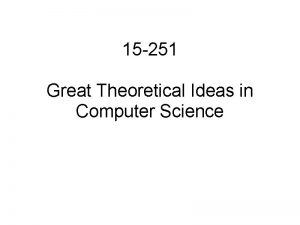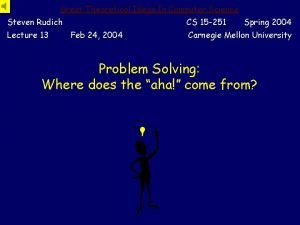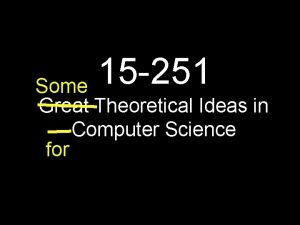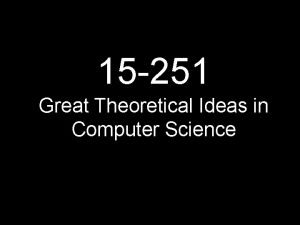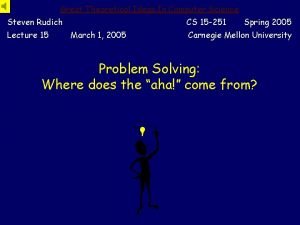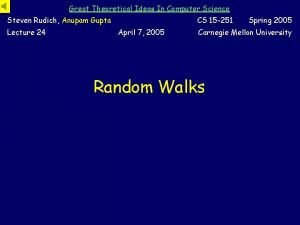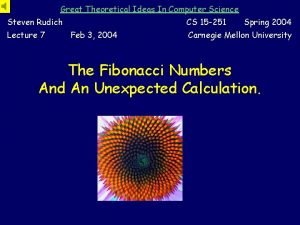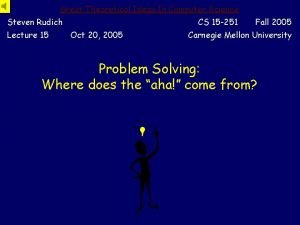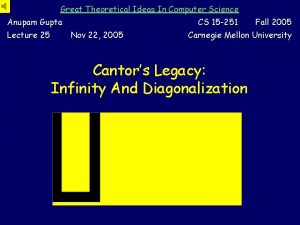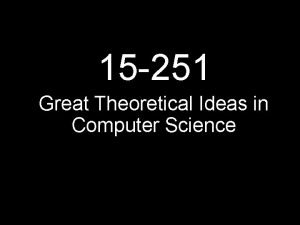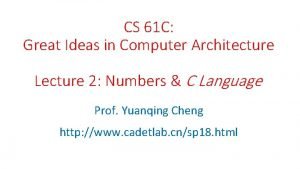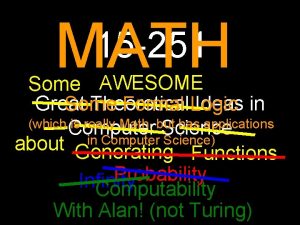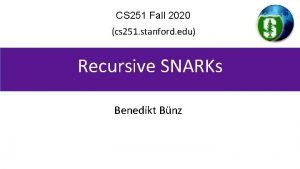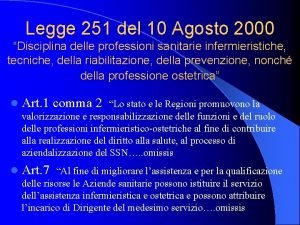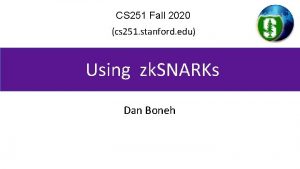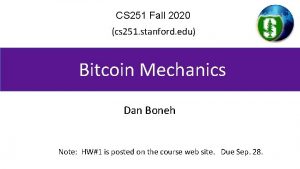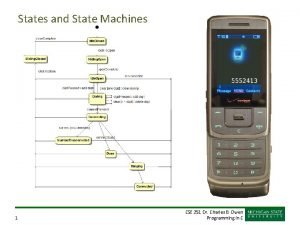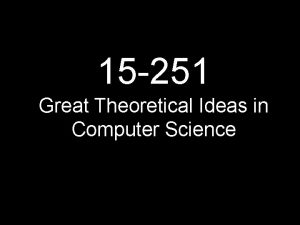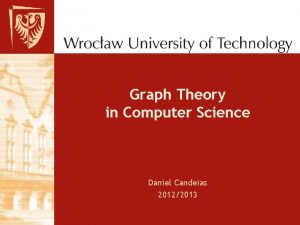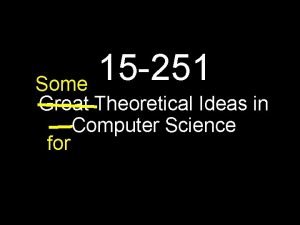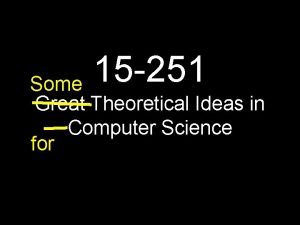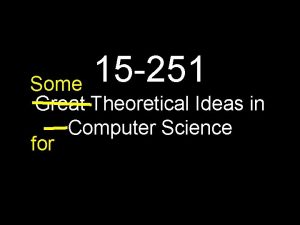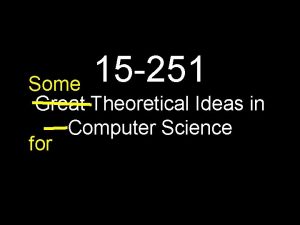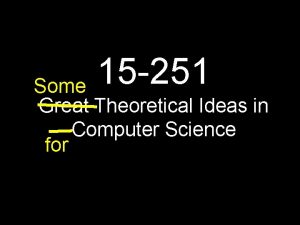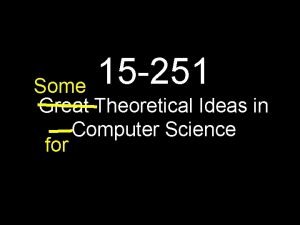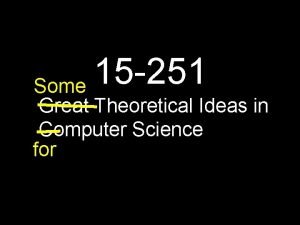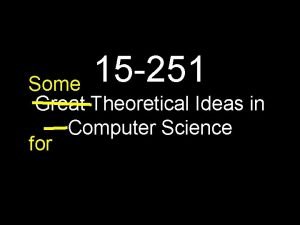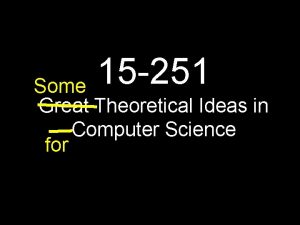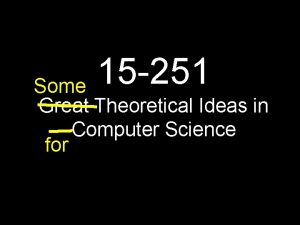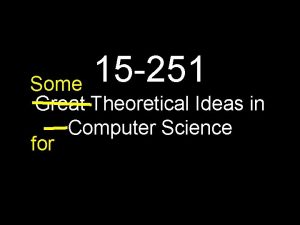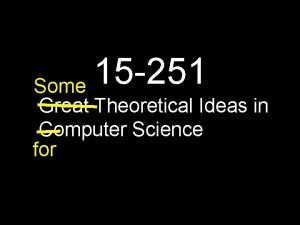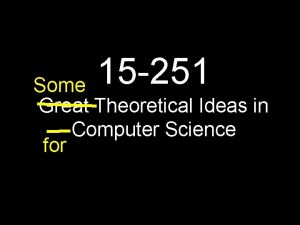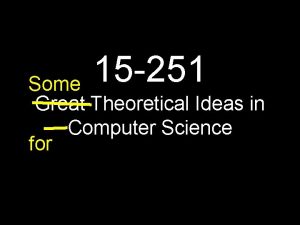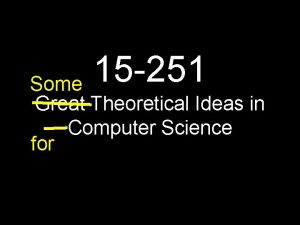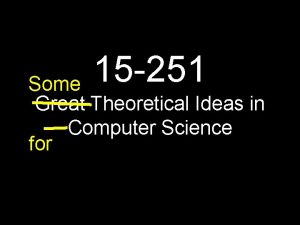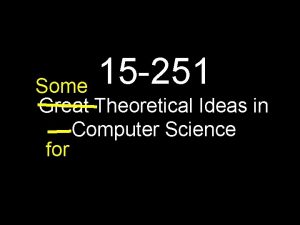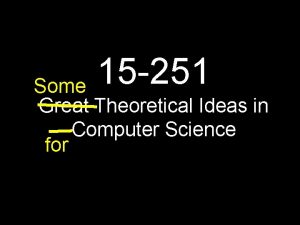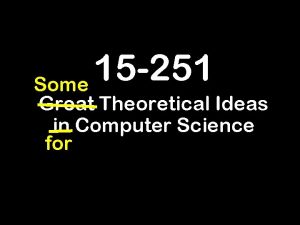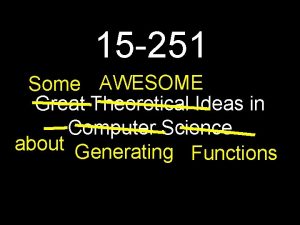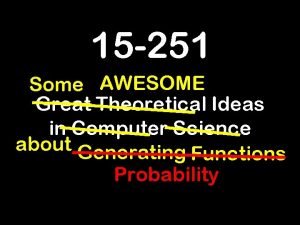15 251 Some Great Theoretical Ideas in Computer































- Slides: 31

15 -251 Some Great Theoretical Ideas in Computer Science for

Group Theory II Lecture 19 (March 25, 2008)

The 15 Puzzle ?

Permutations A permutation of a set X is a bijection : X X We denote the set of all permutations of X = {1, 2, …, n} by Sn | = n! Notation: 12345 = 43215 means (1)=2, (2)=3, …, (5)=5

Composition Define the operation “ ” on Sn to mean the composition of two permutations As shorthand, we will write as To compute , first apply and then : (i) = ( (i)) 123 132 123 231 = 123 321 123 231 = 123 213 This permutation “fixes 2”

Groups A group G is a pair (S, ), where S is a set and is a binary operation on S such that: 1. is associative 2. (Identity) There exists an element e S such that: e a = a e = a, for all a S 3. (Inverses) For every a S there is b S such that: a b=b a=e If is commutative, then G is called a commutative group

(Sn, ) is a Group Is associative on Sn? Is there an identity? YES! YES: The identity function 123…n Does every element have an inverse? -1 12345 = 24531 51423 Is the group commutative? No! YES!

Cycles Let i 1, i 2, …, ir be distinct integers between 1 and n. Define (i 1 i 2 … ir) to be the permutation that fixes the remaining n-r integers and for which: (i 1)= i 2, (i 2)= i 3, …, (ir-1)= ir, (ir)= i 1 (1 2 3 4) = (1 5 3 4 2) = 1234 2341 12345 51423

Examples (1 5 2)(2 4 3) = 12345 54132 (1 2 3)(4 5) = 12345 23154 Two cycles are disjoint if every x moved by one is fixed by the other

(i 1 i 2 … ir) is called a cycle or an r-cycle

Express as the product of disjoint cycles 1 2 w w llo o F F = 1 2 3 4 5 6 7 8 9 6 4 1 2 5 3 8 9 7 = (1 6 3) (2 4)(5)(7 8 9) Theorem: Every permutation can be uniquely factored into the product of disjoint cycles

Express as the product of disjoint cycles = 1 2 3 4 5 6 7 8 9 7 3 2 4 6 1 8 9 5 = (1 7 8 9 5 6)(2 3)(4)

Definition: A transposition is a 2 -cycle Express (1 2 3 4 5 6) as the product of transpositions (no necessarily disjoint): (1 2 3 4 5 6) = (1 6)(1 5)(1 4)(1 3)(1 2) Theorem: Every permutation can be factored as the product of transpositions Is it unique? No! (1 3)(1 2) = (1 2 3) (1 3)(4 2)(1 4) = (1 2 3) But the parity is unique!

There are many ways to factor a permutation into transpositions But, every factorization into transpositions has the same parity of the number of transpositions Definition: A permutation is even if it can be factored into an even number of transpositions A permutation is odd if it can be factored into an odd number of transpositions

Examples 123 123 231 123 321 = (1) is an even permutation = (1 2 3) = (1 3)(1 2) is an even permutation = (1 3) is an odd permutation

Generators A set T S is said to generate the group G = (S, ) if every element of S can be expressed as a finite product of elements in T The set T = { (x y) | (x y) is a transposition in Sn} generates Sn

The 15 Puzzle ?

Let’s Start Simpler 1 2 3 ? 1 3 2

1 2 3 1 3 2 123 123 312 Notation: We will read the numbers in this order: 1 2 4 3 and we will ignore the blank

Reachable Permutations 123 = (1) 123 231 = (1 3)(1 2) 123 312 = (1 2)(1 3) They are all even!!!

1 2 3 No, because ? 1 3 2 123 is an odd permutation 132

The 15 Puzzle ? Similarly, it is possible to prove that only even permutations are possible in the 15 puzzle

Definition: The order of an element a of G is the smallest positive integer n such that an = e (1 2 3)(1 2 3) = (1) What is the order of an r-cycle? r

Subgroups Let G = (S, ) be a group. A non-empty subset H of G is a subgroup of G if: 1. s H s-1 H 2. s, t H s t H Theorem: If H is a subgroup of G, then e (the identity of G) is in H Proof: Let h H Then h-1 H Therefore e = h h-1 H

Examples Is { (1) } a subgroup of Sn? Yes Is { (1), (1 2 3) } a subgroup of S 3? No because (1 2 3)2 is not in it Is { 0, 3 } a subgroup of Z 6? Yes

Lagrange’s Theorem If H is a subgroup of G then |H| divides |G| Proof: For t G, look at the set Ht = { ht | h H} Fact 1: if a, b G, then Ha and Hb are either identical or disjoint Proof of Fact 1: Let x Ha Hb. Then ha = x = kb where h, k H So k-1 h = ba-1 H and (ba-1)-1 = ab-1 H Then Ha = Hb because: If x Hb then x = jb (j H) so x = jba-1 a Ha If x Ha then x = ja (j H) so x = jab-1 b Hb

Lagrange’s Theorem If H is a subgroup of G then |H| divides |G| Proof: For t G, look at the set Ht = { ht | h H} Fact 1: if a, b G, then Ha and Hb are either identical or disjoint Fact 2: if a G, then |Ha| = |H| Proof of Fact 2: The function f(s) = sa is a bijection from H to Ha From Fact 1 and Fact 2, we see that G can be partitioned into sets of size |H|

For p prime, what are all the subgroups of Zp? By Lagrange’s Theorem, the order of any subgroup of Zp must divide p. Therefore, the only subgroups must have size 1 or p: {0} and Zp are the only subgroups of Zp

S 2 = Z 2 = (1) (1 2) (1 2) (1) + 0 1 0 0 1 1 1 0

S 3 Are S 3 and Z 6 Isomorphic? (1) (1 2) (1 3) (2 3) (1 3 2) (1) (1 3) (1 2 3) (2 3) (1 3 2) (1 2 3) (1 3 2) (1 2) (2 3) (1) (1 3) (1 2 3) (1 3) (2 3) (1 2) (1 3 2) (2 3) (1 2) (1 3) (1) (1 2 3)

Permutations Notation Compositions Cycles Transpositions Group Theory Here’s What You Need to Know… Subgroups La. Grange’s Theorem Isomorphisms
 Great theoretical ideas in computer science
Great theoretical ideas in computer science Great ideas in theoretical computer science
Great ideas in theoretical computer science Great theoretical ideas in computer science
Great theoretical ideas in computer science Great theoretical ideas in computer science
Great theoretical ideas in computer science Great theoretical ideas in computer science
Great theoretical ideas in computer science Great theoretical ideas in computer science
Great theoretical ideas in computer science Great theoretical ideas in computer science
Great theoretical ideas in computer science Vocabularize
Vocabularize Great theoretical ideas in computer science
Great theoretical ideas in computer science Great theoretical ideas in computer science
Great theoretical ideas in computer science 8 ideas of computer architecture
8 ideas of computer architecture Cse 111
Cse 111 8 great ideas in computer architecture
8 great ideas in computer architecture Cs61c
Cs61c 8 great ideas in computer architecture
8 great ideas in computer architecture 15-251
15-251 Em nada ponho a minha fé numero
Em nada ponho a minha fé numero Stanford cs251
Stanford cs251 Half lap muff coupling
Half lap muff coupling Legge 251 2000
Legge 251 2000 Cs251 stanford
Cs251 stanford Aecp prerequisites
Aecp prerequisites Cs 251 stanford
Cs 251 stanford Aae 251 purdue
Aae 251 purdue Cse251
Cse251 15-251
15-251 Graph computer science
Graph computer science Sometimes you win some
Sometimes you win some They say sometimes you win some
They say sometimes you win some Cakecountable or uncountable
Cakecountable or uncountable Contact vs noncontact forces
Contact vs noncontact forces Fire and ice diamante poem
Fire and ice diamante poem
